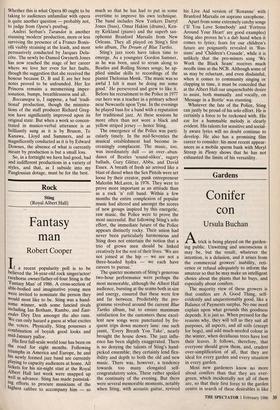Gardens
Conifer con
Ursula Buchan
Atrick is being played on the garden- ing public. Unwitting and unconscious it may be, but the result, whatever the intention, is a delusion, and it arises from the commercial growers' inability, reti- cence or refusal adequately to inform the amateur so that he may make an intelligent choice about the plants that he buys, and especially about conifers.
The majority view of these growers is that conifers are A Good Thing, self- evidently and unquestionably good, like a Balance of Payments surplus. No one need explain upon what grounds this goodness depends. It is just so. When pressed for the reasons why, they will tell us they suit all purposes, all aspects, and all soils (except for bogs), and add much-needed colour in the winter, when deciduous trees have lost their leaves. It follows, therefore, that everyone should grow them, and, crudest over-simplification of all, that they are ideal for every garden and every situation in every garden.
Most new gardeners know no more about conifers than that they are ever- green, which incidentally not all of them are, so that their first foray to the garden centre in search of these desirables is like entering Foyles knowing only that they would like to buy books. For the word `conifer' embraces a group of plants so large and disparate that their affinity is based merely on the fact that they bear cones; in size alone they range from the mighty redwood (why is it always mighty?) to the smallest of prostrate junipers. You see, the nurseryman will say in triumph, there is a conifer for every situation. But how is the customer to choose wisely when all he knows is what he can see for himself: that they all look much the same size in their pots. Without detailed descriptions he can only guess at what height and spread they will ultimately attain. If more people knew even that, there would be fewer Cedrus atlantica `Glauca' branches scratching the panes of picture windows. For the Atlas Cedar has no difficulty growing to 100 feet high and 25 feet wide.
There are conifers which are dwarf, of course. There are also conifers that are slow-growing. The words are not synony- mous, however, as anyone who has had to dig a Chamaecyparis lawsoniana `Ellwoodie out of his rock garden, when it threatened to shade out his saxifrages, will know very well. This is complicated by the `dwarf conifer's habit of reverting back to its original growth habit. Many conifer cultivars originated as branches, which had slow-growing properties, on normal-sized trees. These forms are unstable and it is not unknown for conifers to take it into their heads to reverse the process. This restless enthusiasm for change leads to colour variations, too, which, while satis- fying the commercial grower's insatiable demand for novelty and prompting him to propagate vegetatively any 'sport' or oddi- ty he can find, has the result of releasing on to the market conifers that differ from each other only as much as Tweedledum differs from Tweedledee. They often have inviting names, say, 'Gold Dust', `Goldfinger', or `Golden Dawn', but the gardener may experience more than a little difficulty in telling them apart.
Blithe assurances of labour-free garden- ing with conifers should be treated with caution. The large ones are martyrs to windrock, for they have shallow fibrous roots, and, if care is not taken in siting and staking them when young, a fierce wind in January may well result in unwelcome damage and a heavy lump of an evergreen to remove. Snow breaks the branches unless it is swiftly removed, young plants in exposed positions need the protection of windbreaks if their foliage is not to brown, and anyone who has spent five minutes in a pinetum will know how much Netlon is needed to keep the branches of upright forms properly upright.
As for the fulfilment of the promise of `all-the-year-round interest' this is, in many instances, cataloguese for 'all-the-year- round sameness'. Those trees that con- versely do display particularly attractive winter colour, all too often are seen to fade to a dusty wishy-washyness in summer.
I do like conifers. There is, for me, no tree to surpass a large, uncrowded Western Hemlock or the deciduous Swamp Cypress (has the garden centre told you that there are several deciduous conifers?), or more satisfactory as boundary or divider than a clipped hedge of yew; their importance in providing structure in the garden, as hedges, focal points, or specimens, is indisputable. All I ask is for more discern- ing recommendation in place of a wholesale and misleading emphasis on them as a panacea for all the gardener's maintenance and design problems. If the new gardener is to avoid the seductive trap into which he is lured he should order his conifers from the catalogue of those nurseries, such as Bressingham Gardens, which give expected heights and spreads after ten years, and visit garden centres in the winter to choose those that look particularly fine; after all, the eye will more easily ignore, in the fresh luxuriance of summer, anything that has become dull, shabby or over-familiar.















































 Previous page
Previous page